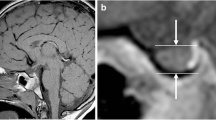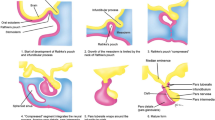Abstract
To search for the presence of morphostructural abnormalities of the hypothalamus-pituitary region in growth hormone deficient (GHD) children magnetic resonance imaging (MRI) was performed in 30 GHD patients (age 10.09±3.5 years) and in 15 healthy agematched controls. MRI demonstrated a significantly small sella and pituitary volume compared to controls and normal literatures values. In 20 patients the structures were extremely small and an abnormal development of the pituitary stalk was observed, and in 18 of these patients the bright spot indicating the neurohypophysis was dislocated to the distal part of the mal-developed stalk, although these children had a normal fluid balance. From a functional point of view hypothalamus and pituitary defects were equally distributed between the two morphological groups. The patients with multiple endocrine defects had the smallest pituitary volume and abnormal stalk. A possible pathogenetic role of perinatal trauma or dysembriogenic events are discussed. A careful follow up of patients with isolated GHD presenting MRI abnormalities of the pituitary is suggested for the possible evolution in panhypopituitarism.
Similar content being viewed by others
Abbreviations
- CT:
-
computed tomography
- GH:
-
growth hormone
- GHD:
-
growth hormone deficiency
- GHRH:
-
growth hormone releasing hormone
- HV:
-
hypophyseal volume
- IGHD:
-
isolated growth hormone deficiency
- MPHD:
-
multiple pituitary hormone deficiency
- MRI:
-
magnetic resonance imaging
- SV:
-
sellar volume
References
Beutler A, Taviere V, Barth MO, Poree C, Lalleman D (1988) MRI findings in primary hypopituitarism with empty sella syndrome in children. Pediatr Radiol 18 (3):252
Chatelain P, Alamercery Y, Blanchard J, Boissel JP, Evain-Brion D, Morre M, Olivier M, Sizonenko P, Van Vliet G (1987) The GHRH European Multicentre Study Group. Growth Hormone (GH) response to a single intravenous injection of synthetic GH-releasing hormone in prepubertal children with growth failure. J Clin Endocrinol Metab 65:387–394
Chihara H, Kashio Y, Abe H, Mihamitani N, Kaji M, Kita T, Takuo F (1985) Idiopathic growth hormone (GH) deficiency, and GH deficiency secondary to hypothalamic germinoma: effect of single and repeated administration of human GH releasing factor (hGRF) on plasma GH levels and endogenous hGRF-like immunoreactivity level in cerebral spinal fluid. J Clin Endocrinol Metab 60:269–278
Chilton LA, Dorst JP, Garn SM (1983) The volume of the sella turcica in children: new standards. AJR 140:797–801
Chiumello G, Natale B di, Pellini C, Beneggi A, Scotti G, Triulzi F (1989) Magnetic resonance imaging in diabetes insipidus. Lancet I:901
Colombo N, Berry I, Kucharczyk J, Kucharczyk W, Groot J de, Larson T, Norman D, Newton TH (1987) Posterior pituitary gland: appearance on MR images in normal and pathologic states. Radiology 165:481–485
Di Chiro G, Nelson KB (1962) The volume of sella turcica. Am J Roentgen 87:989–1008
Fujisawa I, Asato R, Nishimura K, Togashi K, Itoh K, Nakano Y, Itoh H, Hashimoto N, Takecuchi J, Torizuka K (1987) Anterior and posterior lobes of the pituitary gland: assessment by 1.5 T MR imaging. J Comput Assist Tomogr 11:214–220
Fujisawa I, Nishimura K, Asato R, Togashi K, Itoh K, Noma S, Kawamura Y, Sago T, Minami S, Nakano Y, Itoh H, Torizuka K (1987) Posterior lobe of the pituitary in diabetes insipidus: MR findings. J Comput Assist Tomogr 11:221–225
Fujisawa I, Kikuchi K, Nishimura K, Togashi K, Itoh K, Noma S, Minami S, Sagoh T, Hiraoka T, Momoi T, Mikawa H, Nakano Y, Itoh H, Konishi J (1987) Transection of the pituitary stalk: development of an ectopic posterior lobe assessed with MR imaging. Radiology 165:487–489
Gelato MC, Malozowski S, Caruso-Nicoletti M (1986) Growth hormone (GH) response to GH-releasing hormone during pubertal development in normal boys and girls: comparison to idiopathic short stature and GH. J Clin Endocrinol Metab 63: 174–179
Gluckman PD, Grumbach MM, Kaplan SL (1980) The human fetal hypothalamus and pituitary gland: the maturation of neuroendocrine peptides. In: Tulchinsky R (ed) Maternal fetal endocrinology. Saunders, Philadelphia, pp 321–324
Greulich WW, Pyle SI (1959) Radiographic atlas of skeletal development of the hand and wrist, 2nd edn. Stanford University Press, Stanford
Jordan RM, Kendall JW, Kerber CW (1977) The primary empty sella syndrome. Am J Med 62:569–579
Kucharczyk W, Davis DD, Kelly WM, Sze G, Norman D, Newton TH (1986) Pituitary adenomas: high resolution MR imaging at 1.5 T. Radiology 261:761–765
Kulkarni MV, Lee KF, Mc Ardle C, Yeakley JW, Haar FL 91988) 1.5T MR imaging of pituitary microadenomas: technical consideration and CT correlation. AJNR 9:5–11
Inoue Y, Nemoto Y, Fujita K, Aoki H, Takemoto K, Tsukamoto Y, Oda J, Onoyama Y (1986) Pituitary dwarfism: CT evaluation of the pituitary gland. Radiology 159:171–173
Laron Z, Bauman B (1986) Growth hormone releasing hormone (GH-RH, GRF) — an important clinical tool. Eur J Pediatr 145:6–9
Lundberg PO, Gemzell C (1966) Dysplasia of the sella turcica: clinical and laboratory investigation in three cases. Acta Endocrinol 52:478–488
Momoi T, Kikuchi K, Fujisawa I, Yamanaka C, Kaji M, Suda M, Mikawa H (1987) Magnetic resonance imaging in growth hormone deficiency. International Symposium Growth and Growth disorders. Paris, p 3
Natale B di, Scotti G, Pellini C, Del Maschio A, Triulzi F, Petecca C, Uboldi F, Chiumello G (1987) Empty sella in children with pituitary dwarfism: does it exist? Pediatrician 14: 246–252
Peck WW, Dillon WP, Norman D, Newton TH, Wilson CB (1989) High resolution MR imaging of pituitary microadenomas at 1.5 T: experience with Cushing disease. AJR 152:145–151
Radfar N, Raji N, Dastur KG, Drash A (1985) Hypopituitarism in children with “primary empty sella syndrome (PESS)”. Pediatr Res 19:191A
Schriock EA, Lusting RH, Rosenthal SM, Kaplan SL, Grumbach MM (1984) Effect of growth hormone (GH)-releasing hormone (GHRH) on plasma GH in relation to magnitude and duration of GH deficiency in 26 children and adults with isolated GH deficiency or multiple pituitary hormone deficiencies: evidence for hypothalamic GHRH deficiency. J Clin Endocrinol Metab 58:1043–1049
Smith PJ, Hindmarsh P, Kendall B, Brook CGD (1986) Dysgenesis of the corpus callosum and hypopituitarism. Acta Paediatr Scand 75:923–926
Smith SP, Wolpert SM, Sadeghi-Nejad A, Boris S (1986) Value of computed tomographic scanning in patients with growth hormone deficiency. Pediatrics 78:601–606
Stanhope R, Hindmarsh P, Kendall B, Brook CGD (1986) High resolution CT scanning of the pituitary gland in growth disorders. Acta Paediatr Scand 75:779–786
Surtees R, Adams J, Price D, Clayton P, Shalet S (1987) Association of adverse perinatal events with empty sella turcica in children with growth hormone deficiency. Horm Res 28:5–12
Takano K, Hizuku N, Shizume K, Asakawa K, Miyakawa K, Hirose N, Shibasaky T, Ling CN (1984) Plasma growth hormone (GH) response to GH-releasing factor in normal children with short stature and patients with pituitary dwarfism. J Clin Endocrinol Metab 58:236–241
Tanner JM, Whitehouse RH (1976) Clinical longitudinal standard for height, weight, height velocity, weight velocity and stages of puberty. Arch Dis Child 51:170–179
Underwood Le, Radcliffe WB, Guinto FC (1976) New standards for the assessment of sella turcica volume in children. Radiology 119:651–654
Vance ML, Borges JLC, Kaiser DL, Evans WS, Furlanetto R, Thominet JL, Frohman LA, Rogol AD, MacLeod RM, Bloom S, Rivier J, Vale W, Thorner MO (1984) Human pancreatic growth hormone-releasing factor: dose-response relationship in normal man. J Clin Endocrinol Metab 58:838–844
Author information
Authors and Affiliations
Rights and permissions
About this article
Cite this article
Pellini, C., di Natale, B., De Angelis, R. et al. Growth hormone deficiency in children: Role of magnetic resonance imaging in assessing aetiopathogenesis and prognosis in idiopathic hypopituitarism. Eur J Pediatr 149, 536–541 (1990). https://doi.org/10.1007/BF01957687
Received:
Accepted:
Issue Date:
DOI: https://doi.org/10.1007/BF01957687




